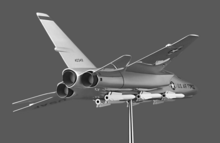
|
|---|
Development of the A-5 had started in 1954 as a private venture by NAA, who sought to produce a capable supersonic long-distance bomber as a successor to the abortive North American XA2J Super Savage. It was a large and complex aircraft that incorporated several innovative features, such as being the first bomber to feature a digital computer, while its ability to attain speeds of up to Mach 2 while carrying a nuclear strike payload was also relatively ambitious for the era. The US Navy saw the value of such a bomber, leading to a contract for its full development and production being issued to the firm on 29 August 1956. The type performed its first flight just over two years later, on 31 August 1958.

During the late 1950s and early 1960s, NAA worked on an improved bomber model, designated A-5B. This took advantage of the zero-wind requirement's elimination to considerably increase the aircraft's maximum weight, the fuselage being redesigned with a hump back to accommodate additional fuel. The wings were also redesigned with enlarged trailing-edge flaps and fully-blown flaps; these changes, when carrying four external drop tanks, roughly doubled the bomber's range. Development was halted after only six A-5Bs had been completed due to a shift in the US Navy's strategic focus that placed less value on manned bombers
Ceiling
MAX RANGE
Aircraft Speed
Max Crew


Designated A3J-1, the Vigilante first entered service with Heavy Attack Squadron Three (VAH-3) in June 1961 at Naval Air Station Sanford, Florida, replacing the Douglas A-3 Skywarrior in the heavy attack, e.g., "strategic nuclear strike" role.
The Vigilante did not end the career of the A-3 Skywarrior, which would carry on as photo reconnaissance aircraft, electronic warfare.
Select models of the F-14 Tomcat would eventually carry the multi-sensor Tactical Airborne Reconnaissance Pod System